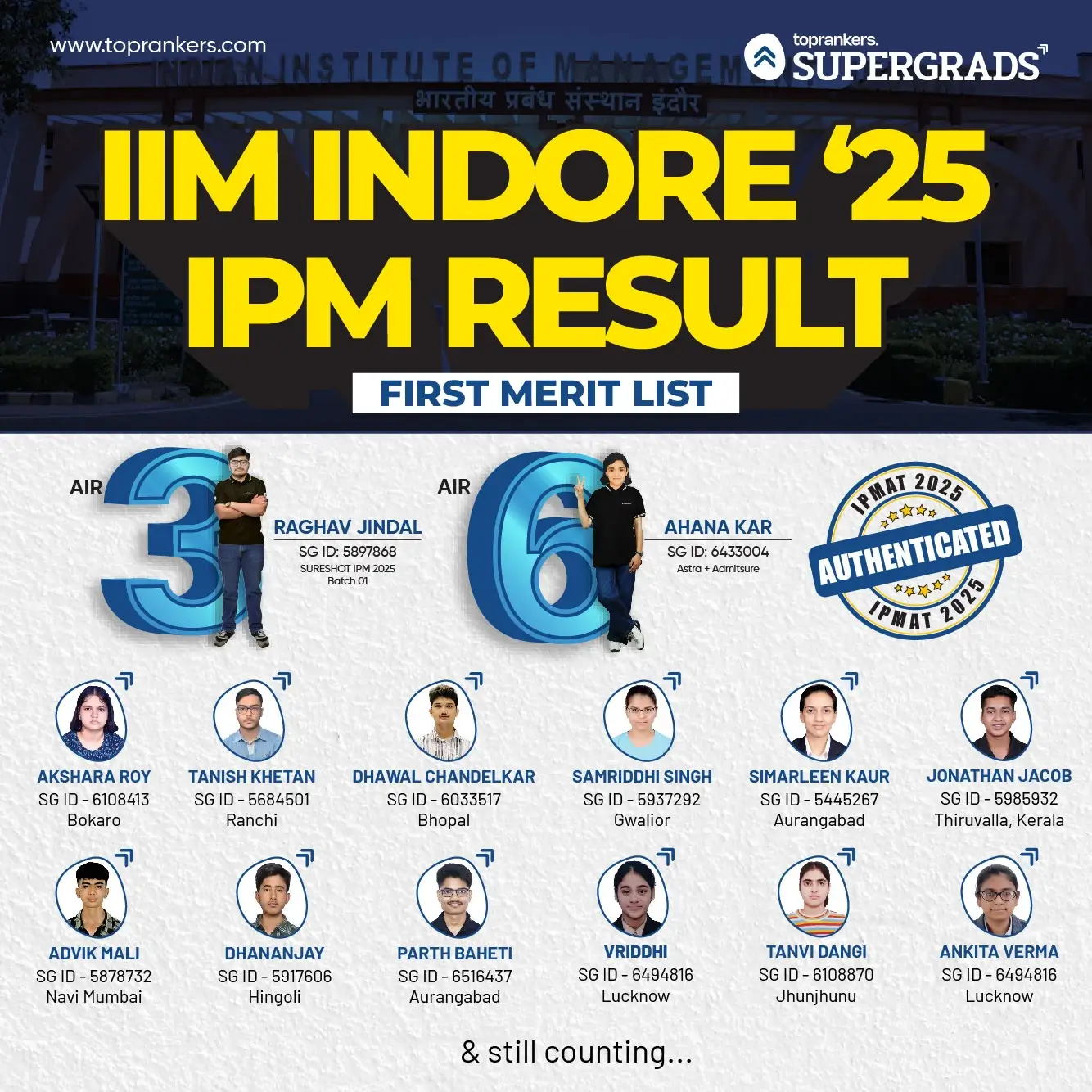IPMAT Aptitude Trailing Zeroes Questions with Answers: IPMAT 2026 Prep
September 4, 2025
Overview: Learn effective strategies to master IPMAT aptitude trailing zeroes questions for 2026. Discover professional strategies, essential formulas, and efficient calculation techniques to boost your performance in the quantitative aptitude section.
Trailing Zeroes is one of the essential concepts under mathematics, and you can expect 2-3 questions from this topic in the Integrated Program in Management Aptitude Test.
As we all know, the quantitative aptitude section holds more weight in the IPMAT 2026 entrance exam.
Hence, it is vital to focus on every concept to score well on the exam.
This post shall guide you through the list of essential IPMAT aptitude trailing zeroes questions with solutions in this post.
Table of Contents
Conceptual Questions Based on Trailing Zeroes for IPMAT 2026
As said above, trailing zeroes is one of the important topics for the IPMAT Exam.
Before moving on to conceptual IPMAT aptitude trailing zeroes questions, it is imperative to understand what a trailing zero is.
Simply put, it is a zero digit with no non-zero numbers to its right. Let us understand this with an example:
9100340560000
In the above example, there are four trailing zeros. Most of you might think three other zeros are in the given number, but they do not count as trailing zeros because other zero digits are less significant.
How many trailing zeros are in the number 10000?
The number 10000 has four trailing zeros, and 1 has four zero digits and no non-zero digit to the right.
How many trailing zeros are in the number 10500?
The number 10500 has only two trailing zeros. Note that there is another zero in the representation of the number, but it doesn't count as a trailing zero because there are non-zero digits to its right.
Another vital concept required to understand trailing zero conceptual questions is the factorial of a number.
The factorial of a whole number 'n' is defined as the product of that number with every whole number till 1.
For example,
2! = 2 x 1 = 2
3! = 3 x 2 x 1 = 6
4! = 4 x 3 x 2 x 1 = 24
Now, let's explore some of the IPMAT Aptitude Trailing Zeroes Questions with answers.
IPMAT Aptitude Trailing Zeroes Questions with Answers
Most of you might be worried about what type of questions are asked from trailing zeroes and the difficulty level of questions.
We have curated important questions from the previous year's IPMAT Question Papers to help you get an idea about the type of trailing zeroes questions asked in the quant section.
Check out the IPMAT trailing zeroes questions with solutions from the post below.
Question 1
Find the Maximum no. of 2’s and 5’s present in the following
- 10!
- 40!
- 100!
Solution
In this question, we have to find the number of factors of 2 and 5 in the given factorial. Calculating the number of 2s and 5s can be done manually, but it will be cumbersome, as shown below.
10! = 10 x 9 x 8 x 7 x 6 x 5 x 4 x 3 x 2 x 1 = 3628800
Factoring terms of 10! In the form of 2’s and 5’s,
10! = (5 x 2) x 9 x (2 x 3) x 7 x (3 x 2) x 5 x (2 x 2) x 3 x 2 x 1
Counting from the above, we have the number of 2’s = 8 and the number of 5’s = 2
This method can be used to solve small factorials but wouldn't be convenient for calculating large numbers like 40!
You can use the following trick to solve these questions quickly and conveniently.
IPMAT Aptitude Trailing Zeroes Questions Trick-1:
To find the maximum power of a prime number, which is a factor of the given factorial number, we have to divide the factorial by the prime number, then divide the integer part of the answer again and again by the prime number up till the answer is not smaller than the prime number.
Better Solution
- 10!
Now solving for 10! using the trick mentioned above,
divide 10/2 = 5 (as the answer is more significant than 2, we will not stop at this stage), now dividing five by the given prime number we get (5/2 = ) 2 (as we have only to take integer values of the answer), finally 2/2 = 1(as 1 < 2, we will stop at this stage)
Ans = 5+2+1 = 8
This method will be accurate for every prime number available in the factorial.
Calculate the number of 5s present in 10!
⇒ 10/5 = 2 (as 2 < 5, we will stop at this stage)
Ans = 2
- 40!
For calculating the number of 2s present in 40!
⇒ 40/2 = 20
⇒ 20/2 = 10
⇒ 10/2 = 5
⇒ 5/2 = 2
⇒ 2/2 = 1 (as 1 < 2, we will stop at this stage)
Ans = 20 +10 +5 +2 +1 = 38
For calculating the number of 5s present in 40!
⇒ 40/5 = 8
⇒ 8/5 = 1 (as 1 < 5, we will stop at this stage)
Ans = 8 +1 = 9
- 100!
For calculating the number of 2s present in 100!
⇒ 100/2 = 50
⇒ 50/2 = 25
⇒ 25/2 = 12
⇒ 12/2 = 6
⇒ 6/2 = 3
⇒ 3/2 = 1 (as 1 < 2, we will stop at this stage)
Ans = 50 + 25 + 12 + 6 + 3 + 1 = 97
For calculating the number of 5s present in 1000!
⇒ 100/5 = 20
⇒ 20/5 = 4 (as 4 < 5, we will stop at this stage)
Ans = 20 +4 = 24
Question 2
Find the highest value of ‘n’ so that 2n completely divides
- 10!
- 100!
- 150!
Solution
- 10!
Here, we must find the power of 2 to completely divide 10! Using the concept discussed above, we calculate the maximum capacity of the prime number available in the factors of the factorial number.
Writing 10! = 2n x N(other factors)
Using the above method
⇒ 10/2 = 5
⇒ 5/2 = 2
⇒ 2/2 = 1
Ans = 5 + 2 + 1
Therefore, 28 is the maximum factor of 2, and the highest value of n would be 8.
- 100!
Writing 100! = 2n x N(other factors)
Using the above method
⇒ 100/2 = 50
⇒ 50/2 = 25
⇒ 25/2 = 12
⇒ 12/2 = 6
⇒ 6/2 = 3
⇒ 3/2 = 1
Ans = 50 + 25 + 12 + 6 + 3 + 1 = 97
Therefore, 297 is the maximum factor of 2, and the highest value of n would be 97.
- 150!
Writing 150! = 2n x N(other factors)
Using the above method
⇒ 150/2 = 75
⇒ 75/2 = 37
⇒ 37/2 = 18
⇒ 18/2 = 9
⇒ 9/2 = 4
⇒ 4/2 = 2
⇒ 2/2 = 1
Ans = 75 + 37 + 18 + 9 + 4 +2 + 1 = 146
Therefore, 2146 is the maximum factor of 2; the highest value of n would be 146.
These were some IPMAT Aptitude Trailing Zeroes Questions with Answers for practice.
Sample IPMAT Aptitude Trailing Zeroes Questions and Answers
IPMAT Aptitude trailing zeroes questions are lengthy and time-consuming. Therefore, you are advised to follow important tips and tricks for the quant section to enhance your IPMAT preparation.
The following are some sample questions with answers based on trailing zeroes for the upcoming exam.
Question 1
Find the highest value of ‘n’ so that 10n ultimately divides
- 100!
- 250!
Solution
- 100!
As 10 is not a prime number, we couldn't use the abovementioned method in question two. For these questions, factorize the term into prime factors form.
Like 10 = 21 x 51
We now need to find the maximum number of 2 x 5 present in 100! Which can be found using the trick mentioned above.
Maximum no. of 2’s present in 100! = 97
Maximum no. of 5’s present in 100! = 24
Therefore, the maximum pairs of 2 x 5 are 24.
Hence answer = 24
- 250!
We must find the maximum number of 2 x 5 present in 250! Which can be found using the trick mentioned above.
Maximum no. of 2’s present in 250! = 244
⇒ 250/2 = 125
⇒ 125/2 = 62
⇒ 62/2 = 31
⇒ 31/2 = 15
⇒ 15/2 = 7
⇒ 7/2 = 3
⇒ 3/2 = 1
Maximum no. of 5’s present in 250! = 62
⇒ 250/5 = 50
⇒ 50/5 = 10
⇒ 10/5 = 2
Therefore, the maximum pairs of 2 x 5 are 62.
Hence answer = 62
Question 2
Find the trailing zeros of 250!
Solution
The number of trailing zeroes of a number is the highest power of n, for which we can completely divide 10n.
Note
Trailing zeros = highest power = highest power of 5
We don't need to calculate the highest power of 2, which we have done above, as the deciding factor is the term having minimum power. This is true only in the case of pure factorials, not in cases like 100! x 5200.
Hence answer = 62.
Question 3
Find the number of trailing zeros at the end of the first hundred multiples of 10
Solution:
Before moving to the solution, try to answer this question independently.
Here, we need to find the number of trailing zeroes in 10 x 20 x 30 x 40 ……x 1000
⇒ (10 x 1 ) x (10 x 2) x (10 x 3 )…… (10 x 100)
⇒ 10100 x (1 x 2 x 3 x 4 ….. x 100)
⇒ 10100 x 100!
⇒ 10100 x 1024 x N (writing 100! = 1024 x N )
⇒ 10124 x N
Hence answer = 124.
Preparation Strategy for Trailing Zeroes Questions in IPMAT
To tackle IPMAT Aptitude Trailing Zeroes Questions, here are some preparation strategies:
Understand the Concept
Understanding what trailing zeroes are fundamental. A trailing zero in a number is any zero that follows all the non-zero digits.
It occurs in multiples of 10. For example, in the number 1500, the two zeroes following the number 15 are trailing zeroes.
Focus on Factorials
Since many trailing zero problems involve factorials, knowing how to handle these large numbers is crucial. Factorials (n!) are the product of all positive integers up to n.
Trailing zeroes in factorials primarily arise from the factors of 5 paired with factors of 2, as every multiple of 5 contributes a zero when multiplied by an even number.
Efficient Calculation Method
1. Divide and Conquer: To find the number of trailing zeroes in a factorial, you don't need to compute the entire factorial. Instead, continuously divide the number by 5 and add the quotients. For instance, to find the trailing zeroes in 100!:
This method works because you are essentially counting the number of times 5 is a factor in the numbers from 1 to 100.
- 1005=20\frac{100}{5} = 205100=20 (first division by 5)
- 205=4\frac{20}{5} = 4520=4 (second division by 5)
- Total trailing zeroes = 20 + 4 = 24.
2. Repeated Division for Prime Factors: If questions require finding the maximum power of a prime number (like 2 or 5) in a factorial, use repeated division by that prime until the result is less than the prime itself:
- For 100! To find the power of 2:
- 1002=50\frac{100}{2} = 502100=50
- 502=25\frac{50}{2} = 25250=25
- Continue until the result is less than 2.
- Sum all the results for the total count of that prime factor.
Practice with Relevant Questions
IPMAT often features questions that test your ability to compute factorials and understand their properties, such as the number of trailing zeroes.
Practice with IPMAT sample questions from previous exams and simulated tests to get a feel for the questions asked and refine your calculation strategies.
Quick Recap for the Exam
Before the exam, ensure to revisit and practice:
- The process of finding trailing zeroes in large numbers and factorials.
- Factorization techniques, especially when dealing with primes.
- Timed practice to enhance speed and accuracy under exam conditions.
Mastering the concept of trailing zeroes is crucial for excelling in the IPMAT's quantitative section.
Efficient strategies and consistent practice help solve IPMAT aptitude trailing zeroes questions, especially in factorials.
This can greatly improve speed and accuracy, leading to better exam performance.
Takeaways:
- Understand the Formula: Understand the formula used to calculate trailing zeroes, especially in factorials.
- Efficient Calculation: Use the division method to quickly find the number of trailing zeroes in factorials without computing the entire factorial.
- Prime Factor Focus: For more complex problems, calculate prime factors (like 2 and 5 in factorials) using repeated division.
- Practice Makes Perfect: Regular practice with IPMAT aptitude trailing zeroes questions for 2026 from previous year papers and IPMAT mock tests to build familiarity and speed.
- Strategic Review: Before the exam, review key strategies and shortcuts for calculating trailing zeroes to ensure a confident and efficient approach during the test.
Frequently Asked Questions
How to find the maximum power of a prime number factor of a given factorial?

What is the best reference book for Quantitative Aptitude preparation for the IPMAT 2026 exam?

What is the best IPMAT revision technique after the syllabus is completed?

How can I improve my accuracy during the IPMAT Maths Preparation 2026?

Which is the best Study Material for IPMAT 2026 Quant Preparation?

Do I need to take specific coaching for IPMAT Maths 2026?

Where can I get IPMAT Aptitude Trailing Zeroes Questions with Answers?








SHARE